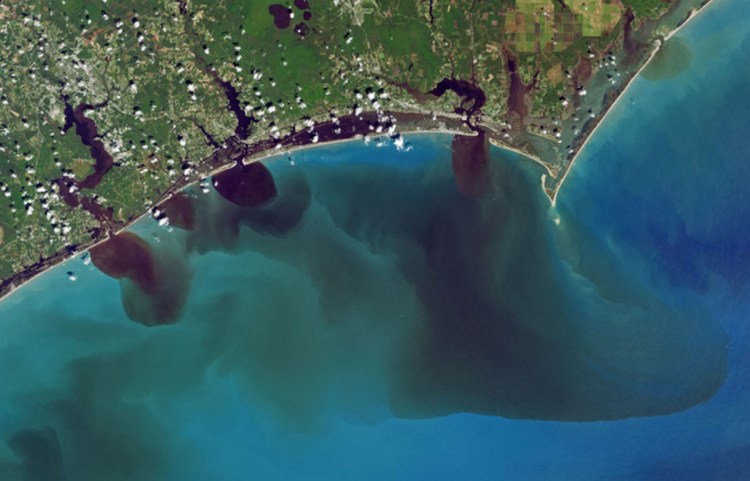Flooding, tornadoes, droughts, wildfires: the evidence of climate change is not just mounting, it’s barreling down on us – inexorable as a landslide. The cost of U.S. weather and climate disasters last year hit an all-time record of $306.2 billion, a figure higher than the combined annual budgets of New York and all the New England states.
Going back as far as the 1980s, our country had an annual average of six “billion-dollar weather events” (where damages exceed $1 billion) until the last five years. From 2013 through 2017, that annual average rose to 11.6 events. Disasters are not just getting more numerous; they’re growing costlier. Rebuilding from Hurricane Florence flooding, Moody’s estimates, could run $50 billion, with costs of Hurricane Michael still to be tallied.
Economic losses don’t begin to account for the full ecological devastation wrought by multiplying disasters. Satellites recorded the inky plume of pollution – extending far off the coast of North Carolina – carrying animal waste and toxic chemicals into the marine ecosystem. Little is known about the long-term costs to fisheries or about the health effects of noxious runoff on drinking-water supplies, groundwater reserves and farm soils.
The wildfires raging out West, beyond aggravating air pollution and carbon emissions, also pose a grave hazard to aquatic health and water supplies.
And for people living at the economic margins without adequate home insurance, the toll exacted by these disasters is incalculable. For them, talk of “recovery” is wishful thinking. Displaced families cannot all afford to repair or rebuild their homes.
One year after Hurricane Harvey hit Texas, flooding nearly 200,000 homes, many residents still live with relatives or amid mold and disrepair. Each new disaster threatens to deepen the income disparities that already fracture our communities.
In countries with far fewer resources than our own, costs of climate inaction run higher still – stoking conflict and forced migration.
Todd Miller, in “Storming the Wall: Climate Change, Migration and Homeland Security,” writes about a rarely acknowledged root of the conflict in Central America’s Northern Triangle (Guatemala, El Salvador and Honduras). Rampant crime there is amplified by the region’s being, in climate scientist Chris Castro’s words, “ground zero” for global warming impact in the Americas. Since 2015, drought has decimated the area. When Miller asked a 17-year-old campesino from Honduras why he was undertaking the dangerous, thousand-mile journey to reach the United States, his answer was simple: “No hubo lluvia” (There was no rain).
Each year, American taxpayers bankroll the U.S. Border Patrol with upwards of $3.8 billion, a figure that has increased more than tenfold since 1990. The tab for the tent cities, hastily built to warehouse growing numbers of migrant children, runs $775 per day for each child. If drought and violence drive these climate refugees to our southern border, shouldn’t their plight inspire humanitarian aid?
But U.S. aid to Guatemala, El Salvador and Honduras fell 20 percent this past year, to $615 million – even as proposals moved forward for a border wall costing more than $23 billion.
Let’s suppose, for a minute, that some of that border spending went instead to targeted aid in the migrants’ home countries; could that stem the influx of immigrants to the United States? A recent World Bank report suggests that migration triggered by climate change in Latin America, sub-Saharan Africa and South Asia could be cut by up to 80 percent with adequate development and adaptation support.
If the United States then spent most of its remaining border billions on reducing the generation of greenhouse gases, would that do us any good? Surprisingly, we might have more to gain than almost any other country from that move.
A study recently published in the journal Nature Climate Change found that for each new ton of greenhouse gases emitted, the United States will be second only to India in the future losses it experiences due to climate change. The study assessed the kinds of impacts we’re seeing today in terms of property and agricultural damage, and higher health and energy costs; it did not factor in other climate challenges that are still growing in magnitude – like rising seas and ocean acidification.
If we maintain “business as usual,” the costs of climate inaction will keep compounding. A new report from the Intergovernmental Panel on Climate Change calls for “rapid, far-reaching and unprecedented changes” to forestall catastrophe. The need for transformation is increasingly dire, yet we’re directing precious dollars to reflexive reconstruction and fantasy “fortress” walls rather than emissions reductions and adaptive measures – here and abroad.
The sad irony of this costly course is that taking steps toward climate stability could actually yield substantial economic rewards. Just how much could we gain by aggressively promoting clean energy systems, sustainable land use and greater manufacturing efficiency? A report by The Global Commission on the Economy and Climate projects that route could yield direct economic gain of $26 trillion around the globe through 2030 when compared to “business as usual.”
Just by reforming energy subsidies and putting a price on carbon, the U.S. government could gain $2.8 trillion in revenues each year.
That’s a tantalizing return on investment, especially when the bonus is a habitable planet.
ABOUT THE WRITER
MARINA SCHAUFFLER is a freelance journalist and editor whose work is online at naturalchoices.com.
Send questions/comments to the editors.



Comments are no longer available on this story